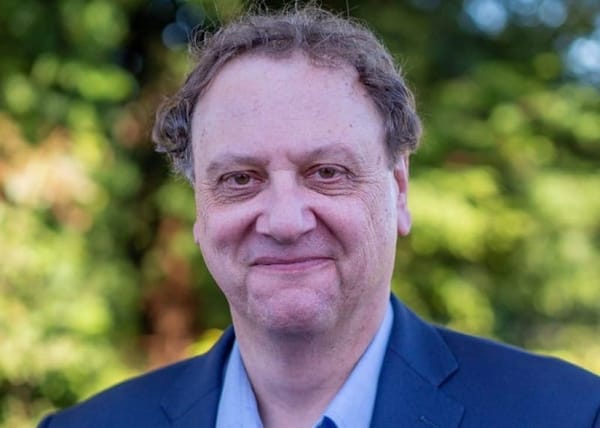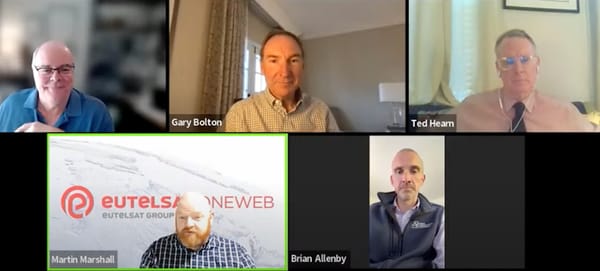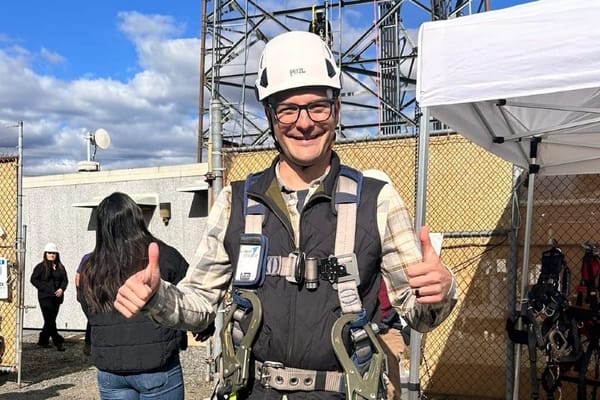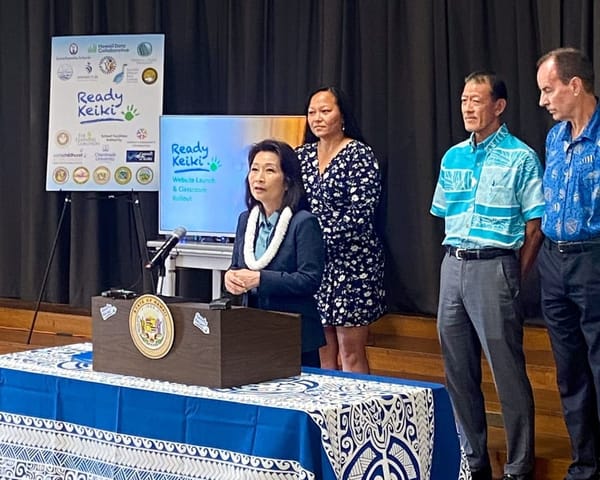Giants of Broadband: A Personal Remembrance of Scott DeGarmo
Editor’s Note: The broadband world has lost three visionary giants over the past several months: Scott DeGarmo, Charles Benton and Don Samuelson. Each of these men had a significant impact on the world of advancing high-speed communications. Personally, each of them also had a significant impact on
Editor’s Note: The broadband world has lost three visionary giants over the past several months: Scott DeGarmo, Charles Benton and Don Samuelson. Each of these men had a significant impact on the world of advancing high-speed communications. Personally, each of them also had a significant impact on my professional career in broadband. I have had countless interactions with each of them over the course of many years.
This series in BroadbandBreakfast.com will provide a personal remembrances of each of them. Comments on the stories are welcome. Feel free to communicate with me via email at drew@broadbandcensus.com.
SALT LAKE CITY, August 31, 2015 – I learned of the passing of Broadband Communities CEO Scott DeGarmo from pancreatic cancer two weeks ago this morning. One of my colleagues on the board of the non-profit Rural Telecommunications Congress had shared the news. His death came just one month prior to his company’s next conference, “Fiber for the New Economy" in Lexington, Kentucky, I immediately sent off my condolences — now joined with dozens of others on the Broadband Communities web site – to those in his company whom I had known and with whom I have interacted on many levels.
For example, many years ago I interviewed Broadband Communities Vice Chairman Hilda Legg when she was the head of the U.S. Department of Agriculture’s Rural Utilities Service during the administration of George W. Bush. I was a reporter for the National Journal Group in Washington. We talked at that time more than a decade ago about the vital importance of getting broadband to rural communities.
Going back even further, Broadband Communities Corporate Editor Steven Ross was a professor of computer-assisted reporting at Columbia University Graduate School of Journalism. This was in 1995-1996, during the infant days of the internet, when I was his student. At the time, all of us were just beginning to sense the impending implications that high-bandwidth connectivity would have for our economy and for our culture
More recently, as practicing attorney working Of Counsel at Kirton McConkie in Salt Lake City, I’ve taken a hands-on role in helping state, municipal and rural broadband leaders to invest in Gigabit Networks. In January, our firm invited Broadband Communities Editor Masha Zager to participate in our webinar series on How to Build Your Gigabit Network." She did a stellar job outlining the world of community broadband networks.
For all of my interactions with the staff and others associated with Broadband Communities, it was clear that Scott DeGarmo was the silent but powerful force behind an impressive organization.
Over the course of more than a decade, he followed and led his industry to a revived and amplified vision of its possibilities. From a small gathering of an obscure line of work dubbed the “private cable business” (think of TV and internet services to multiple-dwelling units), his broadband summits have instead become wonderfully expansive celebrations of the fiber communications marketplace. Whenever I attended Broadband Communities, I found Scott there, shepherding along the growth of this industry.
The Early ‘Broadband Moment’
I met Scott through my friend and mentor Graham Richard, who now runs the Advanced Energy Economy. Graham, the former mayor of Fort Wayne, Indiana, became an advocate for the possibilities that fiber-optic broadband brings to community economic development. After he concluded his term as mayor, he was an advisor and consultant to organizations with which I have worked, including Broadband Breakfast and the Partnership for a Connected Illinois.
It was early 2008, and I had just launched BroadbandCensus.com, an early effort to collect and provide free information to the public about broadband speeds, prices, availability, reliability and competition. President Bush’s Federal Communications Commission had refused to release this data from broadband providers. Our efforts in that year preceded what would become a significant push to increase knowledge where broadband was available, and who was providing it.
Scott graciously invited me to present at what was then known as the Broadband Properties conference, at a hotel near the Dallas airport. At that event, we unveiled our ‘Take the Broadband Census” data-collection form. You could begin to sense that bigger things were in store. Scott saw that, and always attempted to bring the necessary people and organizations together to build up the broadband world. The next year, in 2009, excitement in the internet industry was more pronounced. The conference was thriving in spite of a deep recession. In part, this was because there so many questions about which answers were needed. The administration of President Barack Obama was still in its early months, yet it was designing an ambitious broadband stimulus program. Its watchword was “shovel-ready:” Proposed projects that could be turned into immediate jobs-generators. As I wrote at the time on Broadband Breakfast: Every year, the annual Broadband Properties conference, produced by Broadband Properties magazine, assembles those who literally build the innards of the nation’s fiber-optic infrastructure, the most advanced broadband and internet networks anywhere. They hearken from the private cable industry, where many provided television service to the owners of multidwelling units real properties. They also come from the rural companies and communities that took risks in pioneering fiber investments long before larger companies, like Verizon Communications, woke up to its benefits. Either way, these are the people that are, in the words of Fiber to the Home Council President Joe Savage, “in the dirt-moving industry.” They include glass-makers, wire-splitters, radio frequency engineers, manufacturers of reinforced boxes and racks for digital switches and routers, and consultants to the equipment providers, carriers and local governments. Some are well-known, and some are invisible. They include Calix, CSI Digital, Design Nine, FlexOptics Networks, Foxcom, Light Bridgade, Hitachi Telecom, Motorola, Walker and Associates, among many others. And with $7.2 billion of federal funds about to spent on “middle-mile” fiber-optic infrastructure, conference attendees were eager to learn of others’, and to pitch their own, “shovel-ready” projects.Networking Broadband Connectivity for Illinois
The next phase of my career in broadband took me from the day-to-day journalism and events businesses (over the years, our Broadband Breakfast Club hosted more than 60 different Washington-based discussions on broadband policy and internet technology) to being the technology leader responsible for the State Broadband Initiative in the Land of Lincoln – the Partnership for a Connected Illinois. At the invitation of then-Gov. Pat Quinn, I moved from Washington to Springfield, the state’s capital city, in February 2010. The job to be done was in building a non-profit/quasi-government startup, responsible both for broadband mapping and for community economic development. We were building the organization from scratch, albeit with significant support from the federal and state governments. “I’m glad that our team of broadband experts is moving forward to help achieve the ambitious vision for a public, transparent map of technology infrastructure that President Obama and I share,” Quinn said at the time of my appointment. In part because of my new responsibilities, I missed Scott’s 2010 summit. When I returned to the conference in 2011, 2012 and 2013, it had been rechristened Broadband Communities, and had moved to a better hotel in the exclusive Dallas suburb of Addison. Scott was always conscious of ensuring that the experience of attending the summit was as beneficial for everyone who attended.
Drew Clark at Partnership for a Connected Illinois
As the Executive Director of Broadband Illinois, my focus at Scott’s events was less on reporting and persuading individuals to take the Broadband Census. I was instead working on behalf of Illinois projects, sharing best practices with those who were administering projects in other states, and understanding where fiber-optic technology was heading. With each successive year, Scott put together better and more impressive programs. Personally, I was no longer all about broadband data. My efforts at building the Broadband Census in the early days of the “broadband moment” played some small role in stimulating a much more significant investment in broadband data: The $350 million through the State Broadband Initiatives, in 56 states and territories, under the American Recovery and Reinvestment Act. But at Broadband Illinois we were focused helping to build these networks. I began to see Scott’s Broadband Communities summit as a first-class opportunity for “networking” — of the human and not the fiber-optic variety. Indeed, owing to Illinois’ success in obtaining funds for infrastructure investment (which was the lion’s share of the $7.2 billion in broadband stimulus funds), our organization oversaw about $350 million in fiber-optic and wireless projects in Illinois. We also helped bridge regional divisions within Illinois, enhanced the economic development efforts of the Governor’s Broadband Deployment Council and connected communications providers and users of internet services. Later, we administered two trial programs for enhancing broadband adoption. It was at this time that Scott introduced another innovation at Broadband Communities: The launch of the Economic Development Conference Series in fall 2012. His first event was in Danville, Virginia. When Scott was selecting the location for his second event, in November 2013, he picked a venue in Illinois in south-suburban Chicagoland. Broadband Illinois became significantly involved in the planning and publicity for this event. Among the fiber projects that our organization helped to highlight were the iFiber project, established under the Recovery Act at Northern Illinois University, as well as a separately-financed middle-mile fiber project implemented with state government fund by the South Suburban Mayors and Managers Association. With this regional economic conference being located that year in Tinley Park, Illinois, this provided an opportunity to showcase the “Gigabit Communities Challenge” launched in February 2012 by Gov. Quinn. In a piece about Onlight Aurora, published in advance of a panel discussion at the event, I wrote: Just over a year ago, Illinois Gov. Pat Quinn announced the first of four awards under the state’s “Gigabit Communities Challenge,” an effort to raise the bar on broadband speeds in the nation’s heartland. Of the four awardees named thus far, the Gigabit Network created by Onlight Aurora here is perhaps the most advanced. This is owing to a unique public-private partnership in the state’s second-largest city…. But the example of Onlight Aurora provides an important window into the way Gigabit Networks can help a multiplicity of purposes. These include government cost-savings, traffic solutions, and economic development options for business retention and growth. Scott continued to host these important regional events, holding the September 2014 event in Springfield, Massachusetts. . As previously mentioned, the September 2015 event will be held in Lexington, Kentucky.Partnering with the Rural Telecommunications Congress
I had an additional series of connections with Scott through my role as a board member of the Rural Telecommunications Congress, leading to my being asked to step up as president of that non-profit organization in April of this year. The RTC is a non-profit organization that works with everyone to facilitate the development of a reliable and sustainable rural broadband ecosystem, and hence a strong future for rural America. Its roots date back more than 15 years, when a group of concerned citizens, local and state government officials, consultants, and others met under the aegis of the Aspen Institute in Colorado to discuss how the western states could benefit from the utilization of high speed broadband services. Since 2002, the RTC has hosted events in locales including Des Moines, Iowa; Spokane, Washington; Lexington, Kentucky; Little Rock, Arkansas; Smugglers’ Notch, Vermont; Springfield, Illinois; and Raleigh-Durham, North Carolina. These events have showcased the importance of a strong broadband infrastructure to eliminate the digital divide, enhance the quality of life in rural America and encourage broadband adoption and education in rural America. But in 2010, our organization decided to team up with Scott’s Broadband Communities Summit and Broadband Communities Magazine, and we’ve enjoyed a remarkably productive partnership. “Scott was an easy person to talk to and a good sounding board,” said Galen Updike, president of RTC from 2010-2013, the time that RTC began co-hosting events with Broadband Communities. “He adopted good ideas, such as the transition from the name ‘Broadband Properties’ to ‘Broadband Communities.'” “Scott tried to bring the people to join with the vendors,” said Jane Smith Patterson, president of the RTC from 2013-2015. “It made what the vendors were doing more real, and it got the people in rural broadband more in touch with the vendors.” In a press release from the RTC, I said that “The world of broadband has lost a giant with the passing of Scott DeGarmo. Broadband Communities has been instrumental in the current high profile of rural broadband issues.”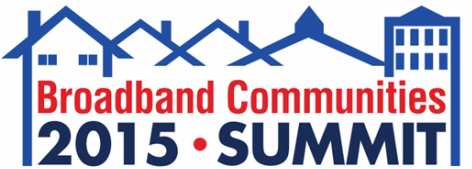
As an example of the high-quality programming that Scott was instrumental in helping to facilitate, I’d point to the April 2015 program, “Connecting Communities Across America: Moving Rural America to Prosper through Broadband.”
That event in April was the first – and only – time that I’ve been to a Broadband Communities event without Scott being there, too. His illness was announced to the public there. Those of us who had worked with Hilda, Scott, Masha, plus Nancy McCain and others on the Broadband Communities team, knew that Scott remained deeply engaged in making that event the success that it was.
He is gone now, and those of us who remain working in broadband will miss his vision and his sense of where the industry was heading next.
Drew Clark is CEO of Broadband Breakfast. He tracks the development of Gigabit Networks, broadband usage, the universal service fund and wireless policy @BroadbandCensus. He works with cities, special districts and private companies on planning, financing and coordinating efforts of the many partners necessary to construct broadband infrastructure and deploy “Smart City” applications. You can find him on LinkedIN, Google+ and Twitter. The articles and posts on BroadbandBreakfast.com and affiliated social media are not legal advice or legal services, do not constitute the creation of an attorney-client privilege, and represent the views of their respective authors.



